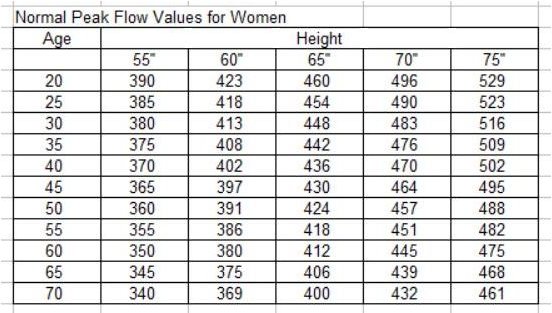
Instruct the patient to use the same meter for each measurement and to take the meter when being evaluated by the practitioner or emergency department (ED) practitioner because there can be variations between meters.Explain that peak flow measurements may be used to guide medication doses on the practitioner’s recommendation 6 and that peak flow measurements may also be taken before and after exposure to potential triggers.Advise the patient that the practitioner may select a more reliable test, such as spirometry, to confirm or exclude airflow limitation. Instruct the patient that although the PEFR is useful for detecting changes in his or her asthma control, significant testing variability can occur. Recognizing this change allows early medical intervention and can prevent severe symptoms. Explain that in many cases the first sign of an “asthma attack” is a decrease in peak flow measurements, even in the absence of symptoms.Instruct the patient to initiate bronchodilator therapy and contact the practitioner immediately or call 911 for emergency medical assistance if the PEFR does not return to the yellow or green zones after bronchodilator therapy. 2 Warn the patient that this signals a medical alert, because airway narrowing and obstruction may be severe. Red is when the PEFR is less than 50% of the patient's personal best.2 The patient should implement the asthma action plan ( Figure 2) (starting by using the rescue inhaler) that the practitioner has established to reverse airway narrowing and regain control of the disease. Yellow is when the PEFR is between 50% and 80% of the patient's personal best, indicating that the patient is getting worse and should use caution.Green is when the PEFR is more than 80% of the patient's personal best, indicating that the patient is doing well and can continue his or her usual maintenance regimen.Instruct the patient to interpret peak flow measurements by using a zone scheme, similar to a traffic light system.Each person may have a personal best that is higher or lower than the average. Explain that peak expiratory flow numbers vary with sex, age, ethnicity, and height.4 The patient's normal PEFR range is 80% to 100% of the patient's personal best PEFR. The highest PEFR value recorded during the 2 to 3 weeks is the patient's personal best. Have the patient enter results and symptoms into a peak flow diary.Instruct the patient to measure and record three PEFRs two to four times daily for 2 to 3 weeks at home when the patient is feeling well and complying fully with his or her asthma therapy.


Peak flow is the most commonly used objective value that can be assessed at the bedside or at home a declining value indicates the patient’s condition is deteriorating or not responding to therapy.
:max_bytes(150000):strip_icc()/200890_color-5bd31a3446e0fb0026ee41f7.png)
PEFR measurement is used to assess respiratory function in obstructive airway diseases (especially asthma) and to evaluate the patient’s response to bronchodilator therapy. Increased bronchospasm or narrowing of the airways results in a decreased speed of air flow.
#Peak flow meter readings full
PEFR is the maximal flow rate that a person can achieve during a short maximal expiratory effort, following a full inspiration. Peak expiratory flow measurement is also known as peak flow or PEFR. In children experiencing acute asthma exacerbations, PEFR correlates poorly with clinical appearance. 2Īnticipate predicted values for peak expiratory flow rate (PEFR) ( Table 1) to be approximately 10% lower for black and Hispanic patients than those shown in predicted peak flow tables. Use a low-range peak flowmeter for small children (typically 8 years old or younger) and use a standard-range peak flowmeter for older children, teenagers, and adults. Most children age 5 or older undefined#ref3">3 are capable of using a peak flowmeter ( Figure 1) as part of their asthma management plan. Do not attempt a peak expiratory flow measurement with patients who have had recent eye surgery after which straining is contraindicated.

Peak Expiratory Flow Measurement - CE ALERTĭo not further stress patients who are severely short of breath or who are hemodynamically unstable by having them use a peak flowmeter.


 0 kommentar(er)
0 kommentar(er)
